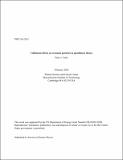Collisional effects on resonant particles in quasilinear theory
Author(s)
Catto, Peter J.
Download20ja005_full.pdf (1.172Mb)
Metadata
Show full item recordAbstract
A careful examination of the effects of collisions on resonant wave-particle interactions leads to an alternate interpretation and deeper understanding of the quasilinear operator originally formulated by Kennel and Engelmann (Phys. Fluids vol. 9, 1966, pp. 2377- 2388) for collisionless, magnetized plasmas, and widely used to model radio frequency heating and current drive. The resonant and nearly resonant particles are particularly sensitive to collisions that pitch angle scatter them out of and into resonance. As a result, the resonant particle-wave interactions occur in the center of a narrow collisional boundary when the collision frequency nu is very small compared to the wave frequency omega. The diffusive nature of the pitch angle scattering combined with the wave-particle resonance condition enhances the collision frequency by (omega/nu)2/3 >>1, resulting in an effective resonant particle collision time of tau_int ~ (nu /omega)2/3 nu <<1/ nu . A rigorous collisional boundary layer analysis generalizes the standard quasilinear operator to a form that is fully consistent with Kennel-Englemann, but allows replacing the delta function appearing in the diffusivity with a simple integral (having the appropriate delta function limit) retaining the new physics associated with the narrow boundary layer, while preserving the entropy production principle. The limitations of the collisional boundary layer treatment are also estimated, and indicate that substantial departures from Maxwellian are not permitted.
Description
Submitted for publication in Journal of Plasma Physics
Date issued
2020-02Department
Massachusetts Institute of Technology. Plasma Science and Fusion CenterJournal
Journal of Plasma Physics
Publisher
Cambridge University Press
Other identifiers
20ja005